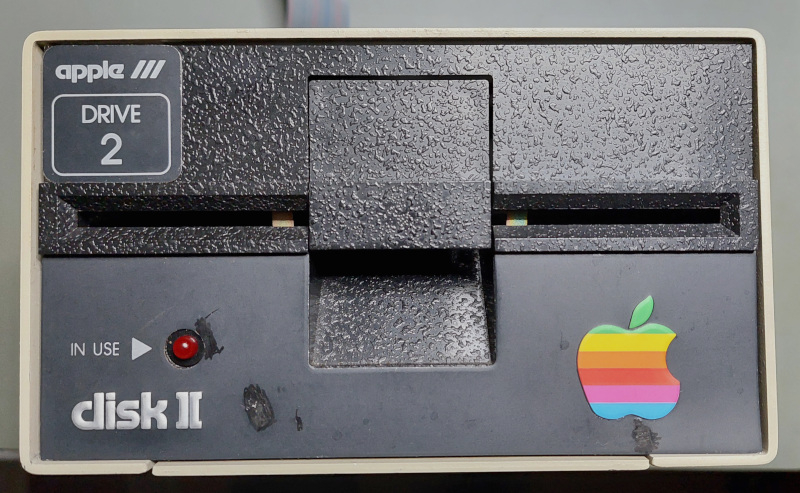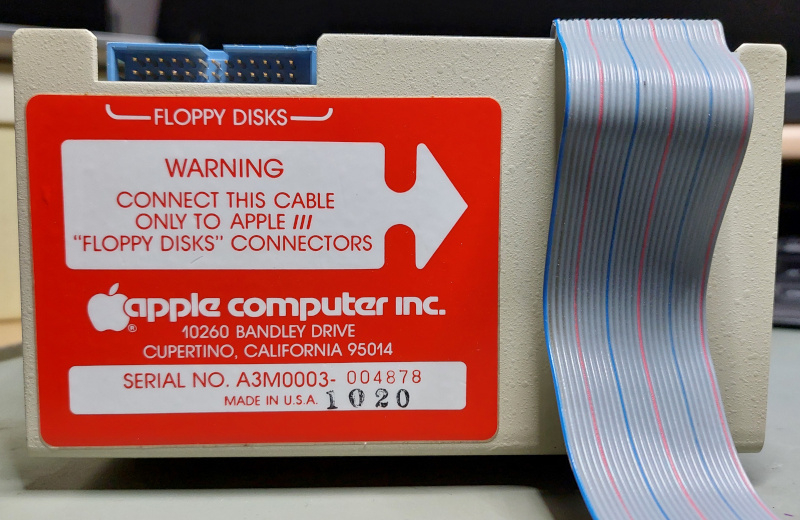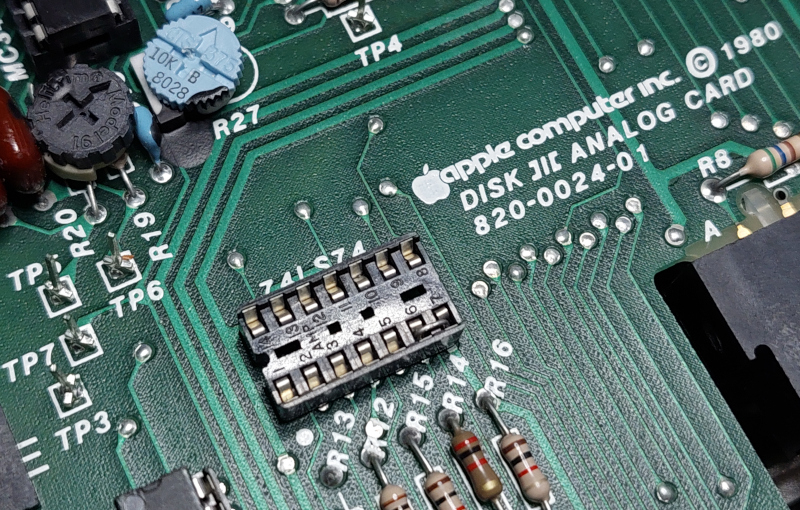Another forum member recently acquired a Disk ][ drive. When it arrived, he noticed something wasn't right: it came with a 26pin cable - matching Apple ///. So it's a "Disk III", not a "Disk II", even if the front label said otherwise.
It is possible to use an adapter to connect a Disk III to an Apple II (to the "Disk II Interface Card"). Or you can make some internal modifications to the Disk III Analog Board, and then simply strip some wires. But the fellow forum member instead decided to send the drive to me - so the "Disk III" was reunited with an Apple III, as it was meant to be. His friendly offer was especially noteworthy, since he lives almost on the other side of the planet... ;-)
So, here are some photos...
The front clearly says "Disk ][". There's also an "Apple /// Disk 2" sticker at the top - but these stickers came extra. You could label them as (external) "drive 2" or "drive 3":
Initially I thought, maybe someone had modified a Disk II, to connect it to Apple III. But the inside reveals an original "Disk III Analog Board". ICs are from 1980, weeks 30-38. Some mechanical components refer to "1980, week 42". So it was made some time after October 1980. Apple /// launched in November 1980, so it's probably from an early batch:
I wasn't aware that there were early Disk III drives, which still came in the old Disk II case. Later Disk IIIs normally look like this - as this one (made in 1982), which has the matching "Apple /// design":
Someone may have transplanted a Disk III Analog Board to a Disk II drive chassis. However, the label on the back shows it's an original Apple III drive. Original sticker - no one has messed with it:
Ok, so early Disk III drives for Apple /// did come in the old Disk II design. Even with the front label incorrectly saying "Disk ][". I didn't know that before.
Looking a bit closer at the analog board... Ooops, what's this?
Someone has messed with the drive after all. What's missing there is the flip-flop IC (SN74LS74). It's one of the little differences between the Disk III and Disk II analog boards. The Disk III logic has a few extra features. One feature is a "sticky write-protect" signal. It allowed Apple /// to reliably detect when an (unprotected) disk had been removed or swapped in the drive. So Apple /// SOS knew, it had to re-read the volume index and the disk allocation table - before writing to the disk again. So, even when you swapped a disk on Apple ///, while SOS wasn't expecting it - there was no danger of the disk becoming corrupted.
If you look even more closely, you can see someone sticked a little wire jumper into the IC socket - connecting pins 6+7. That's connecting one of the missing flip-flop's output pins to ground. It effectively disables the "sticky write-protect" logic - so the write-protect signal behaves like on an original Disk II (for Apple II).
So, obviously someone had made this little modification in order to connect the "Disk III" drive to an Apple II after all (in combination with a stripped 26-to-20pin cable, and connecting two more pins, to make it work)...
So, just for fun - here are both Analog Boards next to each other. The early 1980 "Disk III in Disk ][ disguise" to the left. My newer 1982 "Disk III in Apple /// design" to the right:
(If you look closely: the "Disk III Analog Board" to the left now has its flip-flop IC back. Finally, it's a proud and full-fledged Apple /// drive again...).
And here they are, after probably decades of separation - the "Apple /// family reunion"... ;-)
Not that three floppy drives for an Apple /// are really necessary. But, Apple ///'s mainboard did support three drives (without requiring an additional controller) - and it works. So, why not...
Many thanks to "David", for sending me this drive!









These are not transplants. They're factory drives that were made as a stop gap measure before the plastic shell for disk III was ready.
Well isn't that cool seeing the drive reuinited with an Apple ///